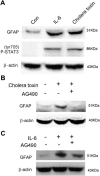Activation of a pro-survival pathway IL-6/JAK2/STAT3 contributes to glial fibrillary acidic protein induction during the cholera toxin-induced differentiation of C6 malignant glioma cells
- PMID: 21470923
- PMCID: PMC5528289
- DOI: 10.1016/j.molonc.2011.03.003
Activation of a pro-survival pathway IL-6/JAK2/STAT3 contributes to glial fibrillary acidic protein induction during the cholera toxin-induced differentiation of C6 malignant glioma cells
Abstract
Differentiation-inducing therapy has been proposed to be a novel potential approach to treat malignant gliomas. Glial fibrillary acidic protein (GFAP) is a well-known specific astrocyte biomarker and acts as a tumor suppressor gene (TSG) in glioma pathogenesis. Previously we reported that a traditional biotoxin cholera toxin could induce malignant glioma cell differentiation characterized by morphologic changes and dramatic GFAP expression. However, the molecular mechanisms underlying GFAP induction are still largely unknown. Here we demonstrate that an oncogenic pathway interleukin-6/janus kinase-2/signal transducer and activator of transcription 3 (IL-6/JAK2/STAT3) cascade mediates the cholera toxin-induced GFAP expression. Cholera toxin dramatically stimulated GFAP expression at the transcriptional level in C6 glioma cells. Meanwhile, phosphorylation of STAT3 and JAK2 was highly induced in a time-dependent manner after cholera toxin incubation, whereas no changes of STAT3 and JAK2 were observed. Furthermore, the IL-6 gene was quickly induced by cholera toxin and subsequent IL-6 protein secretion was stimulated. Importantly, exogenous recombinant rat IL-6 can also induce phosphorylation of STAT3 concomitant with GFAP expression while JAK2 specific inhibitor AG490 could effectively block both cholera toxin- and IL-6-induced GFAP expression. Given that the methylation of the STAT3 binding element can suppress GFAP expression, we detected the methylation status of the critical recognition sequence of STAT3 in the promoter of GFAP gene (-1518 ∼ -1510) and found that it was unmethylated in C6 glioma cells. In addition, neither DNA methyltransferase1 (DNMT1) inhibitor 5-Aza-2'-deoxycytidine (5-AZa-CdR) nor silencing DNMT1 can stimulate GFAP expression, indicating that the loss of GFAP expression in C6 cells is not caused by its promoter hypermethylation. Taken together, our findings suggest that activation of a pro-survival IL-6/JAK2/STAT3 cascade contributes to cholera toxin-induced GFAP expression, which implies that a survival-promoting signal may also play a differentiation-supporting role in malignant gliomas.
Copyright © 2011 Federation of European Biochemical Societies. Published by Elsevier B.V. All rights reserved.
Figures




Similar articles
-
cAMP-induced astrocytic differentiation of C6 glioma cells is mediated by autocrine interleukin-6.J Biol Chem. 2004 Apr 9;279(15):15441-7. doi: 10.1074/jbc.M311844200. Epub 2004 Jan 29. J Biol Chem. 2004. PMID: 14754894
-
Qingnaoyizhi decoction suppresses the formation of glial fibrillary acidic protein-positive cells in cultured neural stem cells by inhibiting the Janus kinase 2/signal transducer and activator of transcription 3 signaling pathway.J Tradit Chin Med. 2015 Feb;35(1):69-76. doi: 10.1016/s0254-6272(15)30011-x. J Tradit Chin Med. 2015. PMID: 25842731
-
MicroRNA 335 is required for differentiation of malignant glioma cells induced by activation of cAMP/protein kinase A pathway.Mol Pharmacol. 2012 Mar;81(3):292-8. doi: 10.1124/mol.111.076166. Epub 2011 Dec 15. Mol Pharmacol. 2012. PMID: 22172575
-
JAK2/STAT3 in role of arsenic-induced cell proliferation: a systematic review and meta-analysis.Rev Environ Health. 2021 Jul 29;37(3):451-461. doi: 10.1515/reveh-2021-0051. Print 2022 Sep 27. Rev Environ Health. 2021. PMID: 34332517
-
GFAP Alternative Splicing and the Relevance for Disease - A Focus on Diffuse Gliomas.ASN Neuro. 2022 Jan-Dec;14:17590914221102065. doi: 10.1177/17590914221102065. ASN Neuro. 2022. PMID: 35673702 Free PMC article. Review.
Cited by
-
Targeting oncogenic miR-335 inhibits growth and invasion of malignant astrocytoma cells.Mol Cancer. 2011 May 19;10:59. doi: 10.1186/1476-4598-10-59. Mol Cancer. 2011. PMID: 21592405 Free PMC article.
-
Transgenic mice with increased astrocyte expression of IL-6 show altered effects of acute ethanol on synaptic function.Neuropharmacology. 2016 Apr;103:27-43. doi: 10.1016/j.neuropharm.2015.12.015. Epub 2015 Dec 17. Neuropharmacology. 2016. PMID: 26707655 Free PMC article.
-
Stochastic modeling suggests that noise reduces differentiation efficiency by inducing a heterogeneous drug response in glioma differentiation therapy.BMC Syst Biol. 2016 Aug 11;10(1):73. doi: 10.1186/s12918-016-0316-x. BMC Syst Biol. 2016. PMID: 27515956 Free PMC article.
-
Effects of AG490 and S3I-201 on regulation of the JAK/STAT3 signaling pathway in relation to angiogenesis in TRAIL-resistant prostate cancer cells in vitro.Oncol Lett. 2014 Mar;7(3):755-763. doi: 10.3892/ol.2014.1795. Epub 2014 Jan 14. Oncol Lett. 2014. PMID: 24520293 Free PMC article.
-
Differentiation of Tumorigenic C6 Glioma Cells Induced by Enhanced IL-6 Signaling.Medicina (Kaunas). 2020 Nov 19;56(11):625. doi: 10.3390/medicina56110625. Medicina (Kaunas). 2020. PMID: 33227992 Free PMC article.
References
-
- Adachi, Y. , Aoki, C. , Yoshio-Hoshino, N. , Takayama, K. , Curiel, D.T. , Nishimoto, N. , 2006. Interleukin-6 induces both cell growth and VEGF production in malignant mesotheliomas. International Journal of Cancer. 119, 1303–1311. - PubMed
-
- Bao, S. , Wu, Q. , McLendon, R.E. , Hao, Y. , Shi, Q. , Hjelmeland, A.B. , Dewhirst, M.W. , Bigner, D.D. , Rich, J.N. , 2006. Glioma stem cells promote radioresistance by preferential activation of the DNA damage response. Nature. 444, 756–760. - PubMed
-
- Bestor, T. , Laudano, A. , Mattaliano, R. , Ingram, V. , 1988. Cloning and sequencing of a cDNA encoding DNA methyltransferase of mouse cells. The carboxyl-terminal domain of the mammalian enzymes is related to bacterial restriction methyltransferases. Journal of Molecular Biology. 203, 971–983. - PubMed
-
- Bird, A.P. , Wolffe, A.P. , 1999. Methylation-induced repression–belts, braces, and chromatin. Cell. 99, 451–454. - PubMed
Publication types
MeSH terms
Substances
LinkOut - more resources
Full Text Sources
Molecular Biology Databases
Miscellaneous

